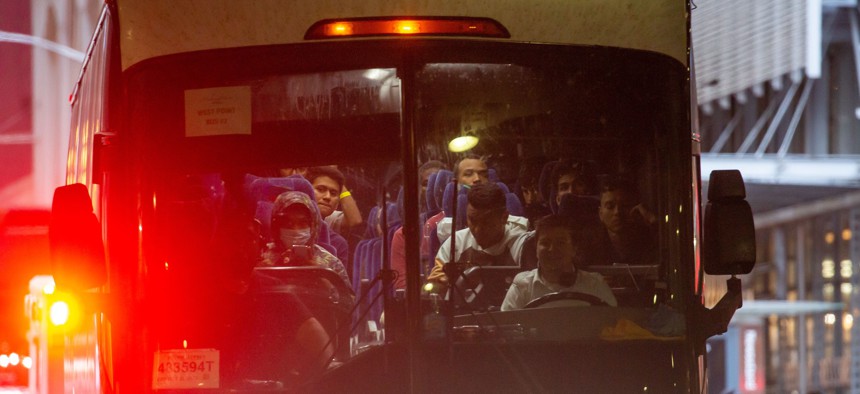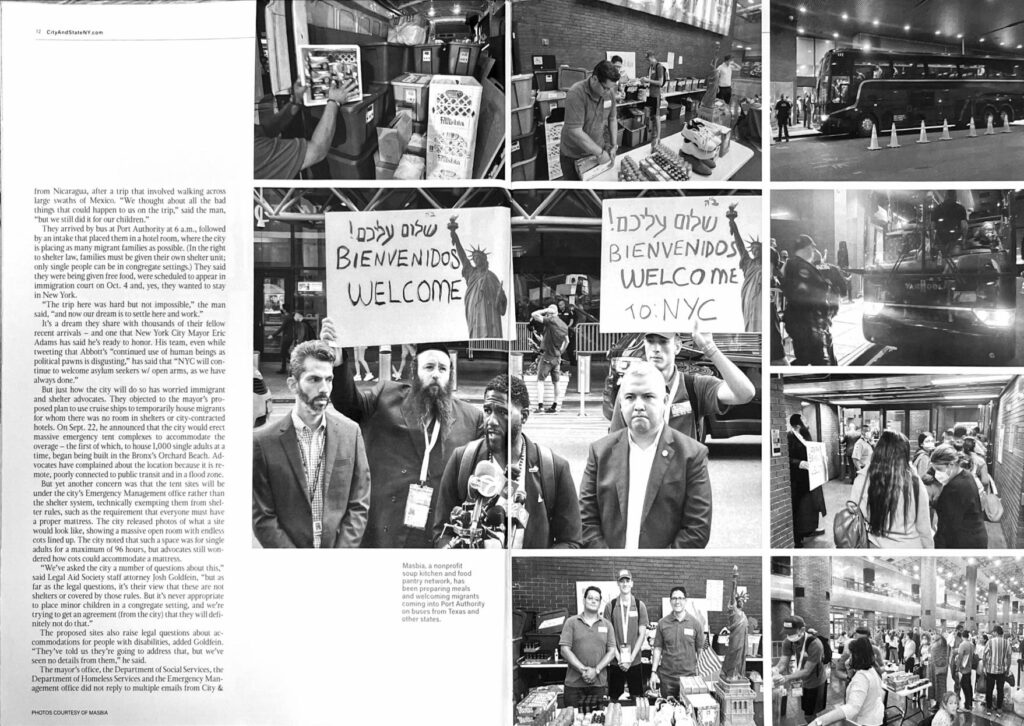Masbia in CityandStateNY: With asylum seekers’ arrival in NYC, shelter advocates worry the city will cut legal corners
Posted on: October 3, 2022The mayor’s plan to temporarily house some arrivals outside the city shelter system, with its stringent criteria, has advocates on alert.

New York City Mayor Eric Adams’ plan to temporarily house some asylum-seekers outside the city shelter system, with its stringent criteria, has shelter advocates on alert. MICHAEL NAGLE/XINHUA VIA GETTY IMAGES
Late in the morning on Sept. 23, roughly 50 new arrivals to New York City – men, women and children, including several toddlers and babies – waited on chairs inside a gated-off section of the main entrance to the Port Authority Bus Terminal. They were surrounded by bags of clothing and food, and several seemed busy feeding children.
No sooner had a reporter begun talking to one family close to the gated perimeter – who said they’d just finished a multipart journey from Venezuela – than a New York City worker rushed over and barked that press were relegated to the bus drop-off area around the corner on 41st Street. That area was empty, except for more security gates and a sign reading “No Press Beyond this Point.”
A few minutes later, several blocks away on West 49th Street close to the Hudson River, a 33-year-old Venezuelan man was sitting on the steps, glued to his phone, outside a massive American Red Cross center, which has been housing intake services for the more than 13,000 people who have come to New York City since the spring, many of them seeking asylum here from Venezuela or other Latin American countries. Some of the asylum-seekers were coaxed or tricked into getting on buses to New York City by Texas and Florida Govs. Greg Abbott and Ron DeSantis – their way of sticking it in the face of northern blue states – but many had come of their own accord, fleeing repressive regimes, poverty, violence and looking to start new lives – whether they already had family and friends here or not.
The influx, which continues at the rate of hundreds of people per week according to the mayor’s office, has pushed New York City’s crowded homeless shelter system to the breaking point. According to a state law like no other in the U.S., New York City must provide immediate accommodation, measuring up to certain health, comfort and safety standards, to anyone who requests it, even if they’re newly arrived to the city.
“We went through several different countries and jungles to get here,” said the Venezuelan man, who arrived recently with his wife, with whom he’s living in a Queens shelter, and his daughter, who is already in school here. The entire journey from Venezuela to New York City took them two months, he said, but now that they’re here, they don’t want to leave. He said he has been finding any cash work available – fixing things, sweeping – “anything that somebody might need.”
He said his dream was to get legal papers, find steady work and be able to send money to his relatives in Venezuela, which he said they left to escape “the president’s regime.” But he added that since arriving in New York, he and his family had received support and were, overall, happy.
Nearby on the sidewalk, another man, 39, his wife, 32, and their son, 9, stood alongside the stroller that held their 1-year-old baby. They had arrived in the city a month ago from Nicaragua, after a trip that involved walking across large swaths of Mexico. “We thought about all the bad things that could happen to us on the trip,” said the man, “but we still did it for our children.”
They arrived by bus at Port Authority at 6 a.m., followed by an intake that placed them in a hotel room, where the city is placing as many migrant families as possible. (In the right to shelter law, families must be given their own shelter unit; only single people can be in congregate settings.) They said they were being given free food, were scheduled to appear in immigration court on Oct. 4 and, yes, they wanted to stay in New York.
“The trip here was hard but not impossible,” the man said, “and now our dream is to settle here and work.”
It’s a dream they share with thousands of their fellow recent arrivals – and one that New York City Mayor Eric Adams has said he’s ready to honor. His team, even while tweeting that Abbott’s “continued use of human beings as political pawns is disgusting,” has said that “NYC will continue to welcome asylum seekers w/ open arms, as we have always done.”
But just how the city will do so has worried immigrant and shelter advocates. They objected to the mayor’s proposed plan to use cruise ships to temporarily house migrants for whom there was no room in shelters or city-contracted hotels, so the mayor walked it back. But then, on Sept. 22, he announced that the city would erect massive emergency tent complexes to accommodate the overage – the first of which, to house 1,000 single adults at a time, began being built in the Bronx’s Orchard Beach. Advocates have complained about the location because it is remote, poorly connected to public transit andin a flood zone.
But yet another concern was that the tent sites will be under the city’s Emergency Management office rather than the shelter system, technically exempting them from shelter rules, such as the requirement that everyone must have a proper mattress. The cityreleasedphotos of what a site would look like, showing a massive open room with endless cots lined up. The city noted that such a space was for single adults for a maximum of 96 hours, but advocates still wondered how cots could accommodate a mattress.
“We’ve asked the city a number of questions about this,” said Legal Aid Society staff attorney Josh Goldfein, “but as far as the legal questions, it’s their view that these are not shelters or covered by those rules. But it’s never appropriate to place minor children in a congregate setting, and we’re trying to get an agreement (from the city) that they will definitely not do that.”
The proposed sites also raise legal questions about accommodations for people with disabilities, added Goldfein. “They’ve told us they’re going to address that, but we’ve seen no details from them,” he said.
The mayor’s office, the Department of Social Services, the Department of Homeless Services and the Emergency Management office did not reply to multiple emails from City & State to clarify any of these details. However, at a Sept. 27 press conference, the mayor appeared to confirm that the tent sites would not be subject to the rules of the shelter system: “The migrant crisis is outside of the housing initiative that we are doing for right to shelter.”
Aside from worries that the emergency sites would not be appropriate, advocates also demanded that the city instantly take a number of steps to free up space in the shelter system for the surge of asylum-seekers.
“There’s no reason in the world the city can’t immediately implement reforms to make it easier for people who are currently in shelter to get (permanent) housing,” said Catherine Trapani, executive director of Homeless Services United, a coalition of about 50 nonprofits that also represents the majority of city-contracted nonprofit shelters.
Among the things the city could do right now, she said, was to cut red tape so that existing shelter residents could get into permanent housing quickly after identifying an apartment and a landlord willing to take public assistance – such asrent vouchersfor families – which landlords must do by law but which can be hard to enforce. The city could also pay off past-due invoices to its shelter providers, which would then allow the providers to open more facilities. It could slow down Housing Court eviction proceedings, which have beenslowly rising.
She added, “There are thousands of vacancies between NYCHA, (the Department of Housing Preservation and Development) and supportive units (for people with special physical or mental health needs) that are currently unfilled for largely bureaucratic reasons.”
She said the city should continue to book asylum-seekers into vacant hotel rooms – a somewhat harder task than it was during COVID-19, when vacancy rates were soaring – and that “there are other types of buildings more permanent than tents located in a flood zone, such as fitness centers and college dorms, that the city could repurpose.”
In reply to a query from City & State running down Trapani’s suggestions, a Department of Social Services spokesperson said via email that the city had taken or was taking several steps related to them, including investing $5.8 million for additional shelter-placement staff in the FY23 executive budget; fund its own rental assistance program (CityFHEPS) without state or federal assistance; pushing for tweaks to state and federal requirements to reduce the paperwork burden on families seeking housing; enhancing its coordinated assessment and placement system, which tracks supportive housing applications, referrals and placements, in order to fill vacancies faster; evaluating other policies to accessing supportive housing; and developing a rental subsidy processing tool and landlord portal to expedite the processing of applications.
The spokesperson also said that some time built into the housing placement process was necessary to make sure that each placement was right for its residents and that landlords were legitimate and scrupulous.
There’s also the issue of how soon those seeking asylum can legally work here – a federal matter. Asylum-seekers are not authorized to work legally for about a year while their case is pending, but Trapani noted that not everyone who has come recently would necessarily be filing for asylum. Recently, President Joe Biden’s administration took steps to streamline the notoriously backed up asylum hearing process.
Meanwhile, a vast network of charity and mutual aid groups have been scrambling to help the city supply the asylum-seekers with everything they need, including food, clothes, toiletries and school supplies as well as legal support and linguistically appropriate mental health counseling. The first week that migrants began arriving at Port Authority, they were met with warm welcome signs, food and new clothes from groups including Artists Athletes Activists as well as Masbia, the latter of which cleaned out the shelves of several Walmarts in order to greet newcomers with new pairs of shoes.

“We saw people arriving without shoes or maybe just flip-flops after being on a bus for 50 hours, so we decided that (giving people new) shoes would help give them back their dignity,” said Alex Rapaport, Masbia’s executive director. The experience was, he said, “surreal – a pop-up Ellis Island feel in a dark back alley,” by which he meant 41st Street, where the buses pulled in.
But advocates stressed the legal burden was on the city to make sure that the newcomers were sheltered properly. It’s a challenge that predated this surge of migrants but one, they insisted, that by law should cover them as well.
“I worry we’re being distracted by a crisis,” Trapani said, “but we have to be able to walk and chew gum at the same time.” When it comes to the ongoing need to shelter people, she said, “We can’t let the bigger pieces fall by the wayside.”
To help Asylum Seekers click here.
Read the original article HERE.




